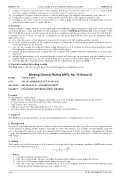Page 522 - Juta's Indirect Tax
P. 522
BGR 015 (2) VALUE-ADDED TAX ACT: BinDing gEnErAL rULingS BGR 016 (2)
(c) issuing a recipient-created tax invoice that complies with the provisions of section 20(4) or (5) or a credit or debit note that complies with the provisions of section 21(1) and (3), as the case may be;
(d) providing the recipient-created tax invoice, credit or debit note to the supplier and retaining a copy thereof;
(e) issuing the recipient-created tax invoice within 21 days from the date of the supply being made; and
(f) retaining a copy of the recipient-created tax invoice, credit or debit note for the period contemplated in section 29
of the TA Act and section 55 of the VAT Act.
3. General
Vendors failing to comply with the criteria stipulated in this BGR may apply in writing for approval to issue recipient- created tax invoices, credit and debit notes by sending an e-mail to VATRulings@sars.gov.za or by facsimile to 086 540 9390. In this regard a clearly motivated application complying with the provisions of section 79 of the TA Act, excluding sections 79(4)(f), (k) and (6), accompanied by the prescribed VAT301 form, must be submitted. These applications must –
(a) describe the nature of the businesses respectively carried on by the supplier and the recipient;
(b) provide a full description of the supplies in respect of which the issuing of the recipient-created tax invoices,
credit and debit notes are required;
(c) s p e c ify the existing invoicing procedures being followed for such supplies as well as the proposed procedures
for issuing the recipient-created tax invoices, credit and debit notes;
(d) i nclude a n u n d ertaking by the recipient that the r ecipient w ill c o mply w ith the requirements of sections 20(2)
and 21(4);
(e) include an undertaking by the recipient that the recipient will enter into an agreement with the supplier that the
supplier shall not issue a tax invoice, credit or debit note in respect of the taxable supplies in question; and (f) state the dif culties experienced in complying with the requirements set out in this BGR.
4. Period for which this ruling is valid
This BGR applies with effect from 1 April 2013 and will apply for an inde nite period.
DATE: ACT: SECTION: SUBJECT:
Preamble
Binding General Ruling (VAT): No. 16 (Issue 2)
30 March 2015
VALUE-ADDED TAX ACT, 89 OF 1991 SECTION 17(1) – APPORTIONMENT STANDARD APPORTIONMENT METHOD
For the purposes of this ruling –
• ‘BGR’ means a binding general ruling issued under section 89 of the Tax Administration Act 28 of 2011; • ‘section’ means a section of the VAT Act unless otherwise stated;
• ‘VAT’ means value-added tax;
• ‘VAT Act’ means the Value-Added Tax Act 89 of 1991; and
• any other word or expression bears the meaning ascribed to it in the VAT Act.
1. Purpose
This BGR prescribes the method to be used in determining the ratio contemplated in section 17(1).
2. Background
Section 17(1) provides that the extent to which a vendor may deduct tax payable on goods or services acquired partly for the purpose of making taxable supplies and partly for some other purpose (for example, exempt supplies or private use) is determined by means of a ratio determined by the Commissioner in terms of a ruling contemplated in Chapter 7 of the Tax Administration Act, 2011 (that is, a binding general ruling) or section 41B (that is, a VAT class ruling or a VAT ruling).
3. Ruling
The formula set out below in respect of the turnover-based method of apportionment constitutes a BGR under section
89 of the Tax Administration Act.
Where:
y = ____a____ × _1_0_0_ a+b+c 1
‘y’ = the apportionment ratio/percentage;
‘a’ = the value of all taxable supplies (including deemed taxable supplies) made during the period;
‘b’ = the value of all exempt supplies made during the period; and
‘c’ = the sum of any other amounts not included in ‘a’ or ‘b’ in the formula, which were received or which accrued
during the period (whether in respect of a supply or not).
514
Juta’s IndIrect tax 2016


